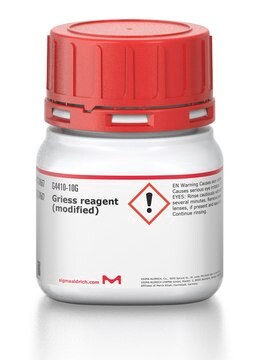S2252
Sodium nitrite
ReagentPlus®, ≥99.0%
Iniciar sesiónpara Ver la Fijación de precios por contrato y de la organización
About This Item
Fórmula lineal:
NaNO2
Número de CAS:
Peso molecular:
69.00
EC Number:
MDL number:
UNSPSC Code:
12352302
PubChem Substance ID:
NACRES:
NA.21
assay:
≥99.0%
grade:
reagent
form:
powder or crystals
Productos recomendados
grade
reagent
Quality Level
product line
ReagentPlus®
assay
≥99.0%
form
powder or crystals
autoignition temp.
914 °F
pH
9 (20 °C, 100 g/L)
mp
271 °C (lit.)
SMILES string
[Na+].[O-]N=O
InChI
1S/HNO2.Na/c2-1-3;/h(H,2,3);/q;+1/p-1
InChI key
LPXPTNMVRIOKMN-UHFFFAOYSA-M
¿Está buscando productos similares? Visita Guía de comparación de productos
General description
Sodium nitrite is an air-sensitive and hygroscopic solid with both reducing and oxidizing properties. It is commonly used as a reagent and catalyst in synthetic organic chemistry. It is decomposed by acids (even weak acids) with the evolution of a brown mixture of nitrogen oxides (NOx).
Application
Sodium nitrite can be used as a reagent in:
It can also be used as a nitrating agent in organic synthesis.
It is used in direct C-H nitration, ipso-nitration, and nitration via transition metal-catalyzed cross-coupling reaction. NaNO2 is also used as a co-catalyst for catalytic oxidation of alcohols under aerobic, solvent-free conditions.
- In the conversion of amines into diazo compounds, which are used as key precursors to many dyes, such as diazo dyes.
- Nef reaction and Abidi transformations.
- The C–C bond cleavage reaction in the presence of TFA under aerobic conditions.
- The oxidative carbonitration of alkenes in the presence of K2S2O8.
It can also be used as a nitrating agent in organic synthesis.
It is used in direct C-H nitration, ipso-nitration, and nitration via transition metal-catalyzed cross-coupling reaction. NaNO2 is also used as a co-catalyst for catalytic oxidation of alcohols under aerobic, solvent-free conditions.
Legal Information
ReagentPlus is a registered trademark of Merck KGaA, Darmstadt, Germany
signalword
Danger
hcodes
Hazard Classifications
Acute Tox. 3 Oral - Aquatic Acute 1 - Eye Irrit. 2 - Ox. Sol. 3
Storage Class
5.1B - Oxidizing hazardous materials
wgk_germany
WGK 3
flash_point_f
Not applicable
flash_point_c
Not applicable
Elija entre una de las versiones más recientes:
¿Ya tiene este producto?
Encuentre la documentación para los productos que ha comprado recientemente en la Biblioteca de documentos.
Los clientes también vieron
Arda Gülay et al.
mBio, 10(6) (2019-11-07)
Nitrification, the oxidative process converting ammonia to nitrite and nitrate, is driven by microbes and plays a central role in the global nitrogen cycle. Our earlier investigations based on 16S rRNA and amoA amplicon analysis, amoA quantitative PCR and metagenomics
Anne C Rios et al.
Cancer cell, 35(4), 618-632 (2019-04-02)
Breast tumors are inherently heterogeneous, but the evolving cellular organization through neoplastic progression is poorly understood. Here we report a rapid, large-scale single-cell resolution 3D imaging protocol based on a one-step clearing agent that allows visualization of normal tissue architecture
Lucas C Pinheiro et al.
Free radical biology & medicine, 53(4), 701-709 (2012-06-23)
The new pathway nitrate-nitrite-nitric oxide (NO) has emerged as a physiological alternative to the classical enzymatic pathway for NO formation from l-arginine. Nitrate is converted to nitrite by commensal bacteria in the oral cavity and the nitrite formed is then
Edward H Oldfield et al.
Journal of neurosurgery, 119(3), 634-641 (2013-05-28)
Intravenous sodium nitrite has been shown to prevent and reverse cerebral vasospasm in a primate model of subarachnoid hemorrhage (SAH). The present Phase IIA dose-escalation study of sodium nitrite was conducted to determine the compound's safety in humans with aneurysmal
Paul J Shami et al.
Journal of medicinal chemistry, 49(14), 4356-4366 (2006-07-11)
The literature provides evidence that metabolic nitric oxide (NO) release mediates the cytotoxic activities (against human leukemia and prostate cancer xenografts in mice) of JS-K, a compound of structure R(2)N-N(O)=NO-Ar for which R(2)N is 4-(ethoxycarbonyl)piperazin-1-yl and Ar is 2,4-dinitrophenyl. Here
Nuestro equipo de científicos tiene experiencia en todas las áreas de investigación: Ciencias de la vida, Ciencia de los materiales, Síntesis química, Cromatografía, Analítica y muchas otras.
Póngase en contacto con el Servicio técnico









